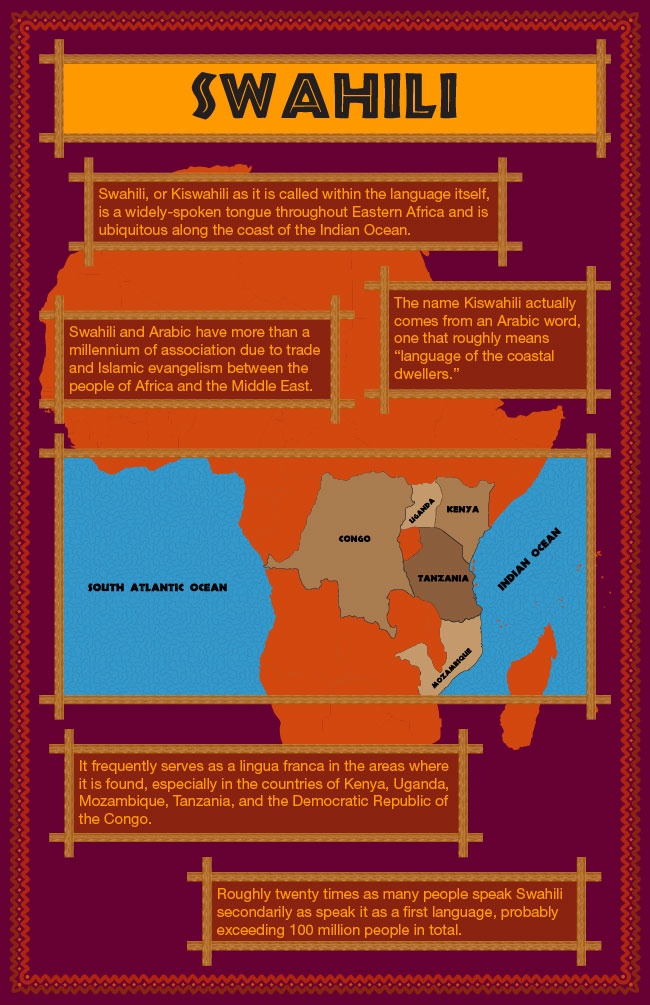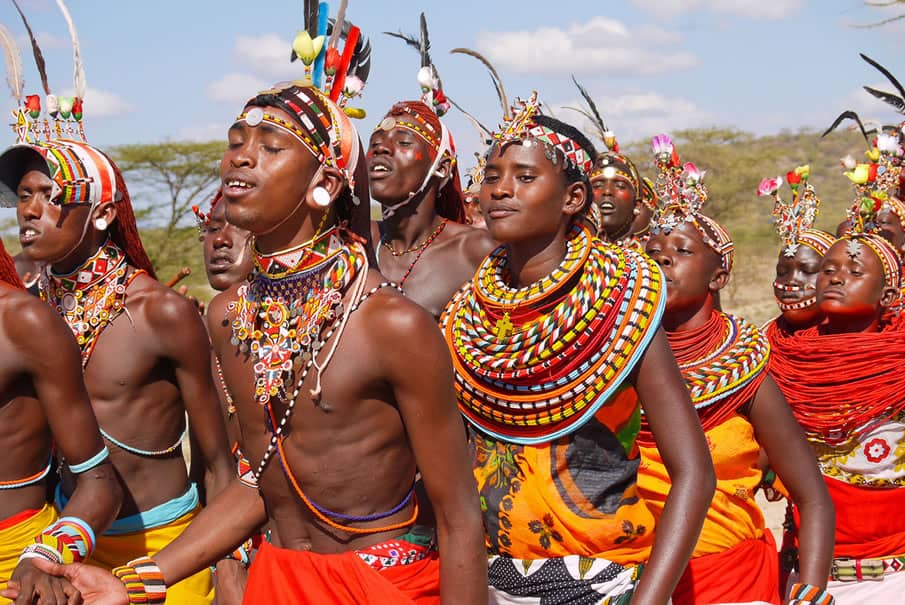The origins of the Swahili Langauge
Swahili is known as the language of the Swahili people. It is also called Kiswahili (coast language). It is spoken in a large portion of Africa, including Tanzania, Kenya, Rwanda, Uganda and the Democratic Republic of the Congo. Estimates of the number of speakers vary widely, and this may be due to the fact that it is hard to identify native speakers as opposed to second-language users; the language is used as a lingua franca in the African Great Lakes region, as well as other parts of Africa. It has official status in a number of these countries as well.
Swahili is considered a Bantu language in terms of language family, which stems from the Niger-Congo branch of the language tree. There are a number of other African languages in this categorization, including Zulu and Shona. Interestingly, vocabulary influences also include Arabic and Sanskrit. Arabic influence came from Muslim inhabitants in the region, as the Swahili people have historically been Muslim as well, while Sanskrit influence stemmed from interactions with Indian merchants. Words from Arabic and Sanskrit are prevalent in Swahili vocabulary, in addition, Arabic script has been historically used to write Swahili as well.
Swahili may be unique to those outside of Africa because of a number of linguistic factors. Firstly, the noun class system is quite different to more well-known languages, which is signified grammatically. These classes include ones related to people, ones related to groups, ones related to expanses (such as lake or valley), and even ones related to trees. Depending on what class a noun belongs in, their interaction with adjectives differ. This can be somewhat comparable to Romance languages, where adjectives agree with grammatical gender, but in the case of Swahili, the classes are more extensive and expansive in meaning.
Swahili used to be written using an Arabic script. Few adaptations were made for sounds native to Swahili and there was large variety within the spelling at this time. This resulted in difficulties of how words were written. Now, Swahili is written in an alphabet derived from English, which is a Latin-based script. While similar to English, there is the exclusion of Q and X from the official set. There are many aspects unlike English, however. For example, particles are written together with the noun as one word, while grammatical patterns like tense are written separately from the word. The Swahili writing system, like all Latin-based systems is written from left-to-right.

Historically, it was known as Kingozi and is quite different from the Swahili we know today. However, traders and merchants that spoke Arabic, Persian, and languages in India came. Such interaction influenced the development of vocabulary as vocabulary from these languages entered the Swahili inventory.
During colonial periods of regions of Africa in which Swahili was spoken, Christian missionaries introduced the Latin alphabet to the Swahili people, who in turn used it to communicate with other ethnic groups, spreading the language. During this period, it was the language of commerce in East Africa. With a lack of standardization, efforts by colonial administrators started to create rules and a standard dialect. The Zanzibar dialect was chosen as the standard. This standardized Swahili was adopted as the language of administration in many Swahili speaking areas, and also became the basis of a national language, most notably in Tanzania. In neighboring countries, Swahili also is used at an official level, including Kenya and Uganda.
Swahili also has a tradition of literature dating back to the 18th century. At this time, all Swahili writing was written in Arabic, but some of these writings have been preserved. In the 19th century, with the introduction of the Latin script, Swahili literature continued to be written. However, it is hard to establish a canon due to the nature of the Swahili language; while there is a standard, there is much variety as well, and this dialectal and regional variety is reflected in the writing.
Due to the commercial history of the language and its power as a lingua franca, Swahili has become a language to many people, especially in the countries of the African Great Lakes, the Democratic Republic of Congo, Kenya, and Tanzania. In these countries, it is an official language.
Currently, as Swahili is spoken over such a wide region that identifies with tribes and ethnic communities, there are about 15-17 dialects. While these dialects are overall intelligible, some can be quite different in pronunciation and vocabulary, which may lead to unintelligibility. These dialects are usually based on region. In addition to the main African continent, there is also a large and noteworthy Swahili speaking population in Oman.
VEQTA can provide you with a perfect Swahili translator for your Swahili translation, English to Swahili translation and Swahili to english translation for the your targeted locale. Our translations to swahili are created with your target audience in mind to meet your expectations.
If you need to translate Swahili – Get in touch today!
A dedicated team of Swahili translators who combines Experience, Specialized Subject Matter Expertise with best Translation Practices to deliver quality second to none.
Swahili Document Translation
Swahili Legal Translation
Swahili I.T Translation
Swahili Health & Fitness Translation
Swahili Medical Translation
Swahili Marketing Translation
Swahili Financial & Accounting Translation
Swahili Tourism & Travel Translation


